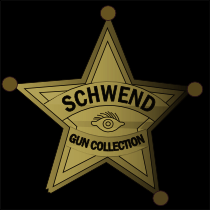
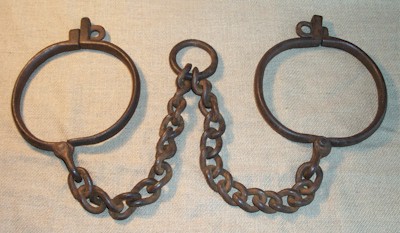 |
Mid-19th
Century Slave/Convict Neck Irons Neck Irons Manufactured circa 1850's This set of irons was used to chain a group of men together. The large loops were placed around the necks of two men, locked and then were linked together with another pair of unfortunate souls by a central chain that passed though the linking loop in the center. This is the origination of the "Chain Gang" phrase that meant the entire group was linked by chain. This particular pair saw use by slaves as they pre-date the 1860's and then for use by prisoners thereafter. Neck irons were considered cruel and unusual punishment and were later replaced by leg irons. Most often they would have been used in the transport of slaves or prisoners from one location to another. |
|
|
Animal Hide Scales These scales were part of the original Schwend Collection. They were used to weigh animal skins in order to establish a price to be paid by fur traders. These scales were manufactured in Germany and were used in the area of Henrietta, Clay County, Texas to weigh Buffalo hides in the mid to late 1870's. By 1880, the Buffalo were no longer in the Wichita Valley as they had been hunted to near extinction. With their disappearance, Indian depredations ceased as well. It is highly likely that these scales were brought to this country from Germany by the original Schwend ancestors in the mid 1850's. |
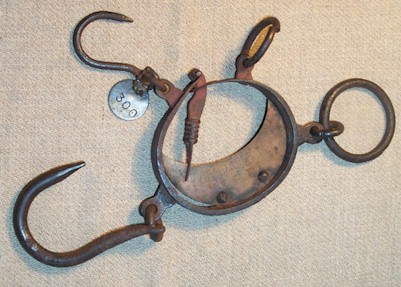 |
|
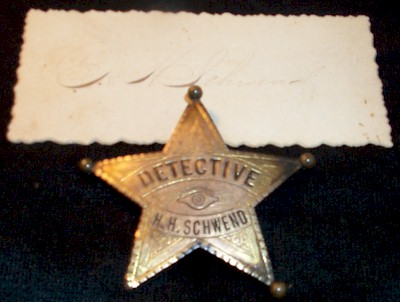 |
Henry
Harrison Schwend Badge & Calling Card Shown at left is Harrison Schwend's gold badge he wore while a detective in Henrietta, Clay County, Texas around 1900. The calling card above the badge is a personal signature card that was signed by him reading "H.H. Schwend". It is signed in ink. |
|
|
Scottish
Chieftain Knife Scabbard Remains This is all that remains of a beautiful knife and scabbard. Family records state that "the knife is heavy. The blade has a carved ebony hilt, studded with brass and bound at the bottom with heavy silver bands. In the top of the hilt is a large empty socket, possibly the setting for ball of some metal, or a jewel of some sort. The scabbard is made of wood, leather and silver, the latter elaborately engraved" (see the remains on the bottom right). Along the scabbard were deep narrow sockets with holders (2 upper pieces on right) for storage of two smaller knives (never found). These holders are inscribed in Latin "Sans Peur" and "Ne Obliviscaris" which translate to "Without Fear" and "Forget Not" respectively. Research has shown that these Latin phrases and the attendant carvings form heraldic family crests. The first on the upper left with the "Sans Peur" inscription also features a sejant cat which forms the crest of the Sutherland family of Scotland who inhabited the land south of Caithness, the "south land". The crest on the upper right piece features a Boar's Head with the Latin phrase "Ne Obliviscaris" form the heraldic elements of the Campbell clan, also of Scotland. It can only be surmised that at some point in history, these two families joined together either through marriage or formal alliance and this dagger represents that union. It is believed that this dagger dates to the 1600's. |
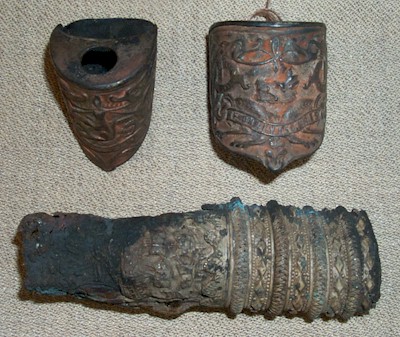 |
|
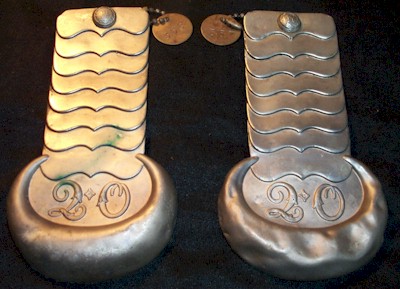 |
Pair
of Military Shoulder Boards These "Epaulets" as they were known were worn on the shoulders as a decoration to a military uniform. Many were made from fabric and very ornate. Boards such as these would probably have been worn as battle dress since they are made from metal and might afford some meager protection, especially from a sword strike. The metal buttons at the top contain the cipher "Queens Own W.Y.O." with a "VR" cartouche in the center. The "VR" cartouche is the designation for Queen Victoria who reigned the English Empire from 1837 to her death in 1901. The large "20" would probably represent a regiment number. These are English, mid 19th Century. |
|
|
Jesse
James Coin Purse Remnant This small coin purse was once the property of the outlaw Jesse James. The purse was given personally to Harrison Schwend by Frank James along with a note from Frank with his compliments dated May 8, 1914, less than a year before Frank's death. The bag portion of the purse was burned away in the Museum fire of 1988 but was originally the scrotum sac from a bull. It is believed that this face to face encounter between Schwend and James occurred at the time that the Younger/James Wild West Show was appearing in Henrietta, Clay County, Texas in 1914. The aforementioned note and purse were accompanied by a Cartridge Belt used by brother Jesse during his infamous career, which was also destroyed in the fire. |
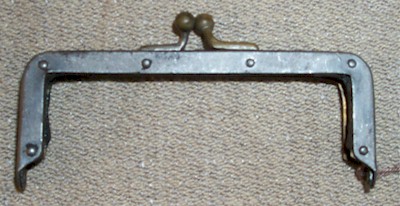 |
|
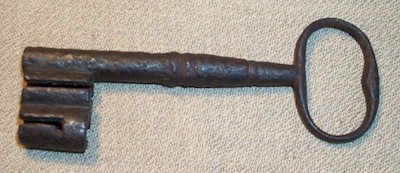 |
Key
from Henrietta, Texas Jail This key which is listed in the Museum inventory list, appears in original family photos of the collection, and described in other family narratives was supposedly one of the jail keys to the first "calaboose" in Henrietta which was built in 1878 and ultimately replaced by the 1890 jail building, home to the Clay County Historical Society and Museum. The original jail was located on the western side of the courthouse square and faced the courthouse itself. See photo below of this original building. 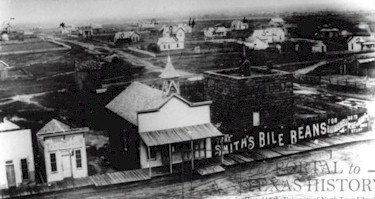 The original jail building is the stone structure behind the "Beans" sign. The sheriff's office can be seen at the lower left front. |
|
|
James
B. Bonham Musket Trigger Guard This remnant trigger guard was once part of a Kentucky Rifle owned and used by James Butler Bonham (1807-1836) at the siege of the Alamo in which he lost his life along with 189 other defenders on March 6, 1836. Bonham met his death defending the east wall of the old mission. He was 29 years old. The original rifle was a 36 caliber model built in the late 1820's. |
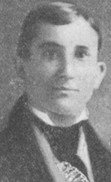 |
 |
IF YOU HAVE ANY INFORMATION
ON THE WHEREABOUTS OF GUNS, PIECES OR PARTS FROM THE GRAND PRAIRIE WAX MUSEUM
FIRE OF 1988, PLEASE EMAIL: schwendguns@gmail.com.
MAYBE YOU'VE SEEN A TAGGED GUN AT A SHOW OR KNOW SOMEONE WHO HAS A SURVIVING
PIECE. I AM ACTIVELY SEEKING AND WILL PURCHASE COLLECTION PIECES.
THANK YOU!
HOME ABOUT GALLERY 1 GALLERY 2 GALLERY 3 BOOK CONTACT